Walking Wounded Indonesia!!!

Peregrina's Journey
Peter and Margie Benziger
Thu 8 Sep 2011 13:53
Walking Wounded…
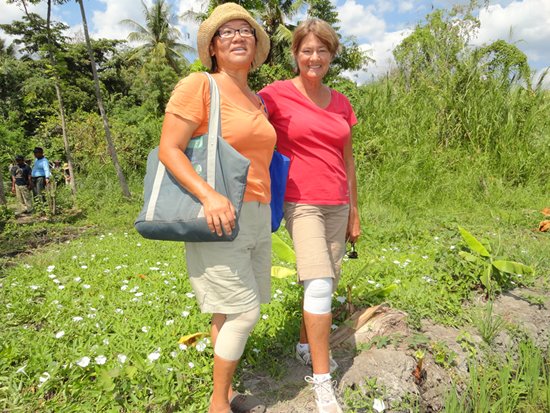
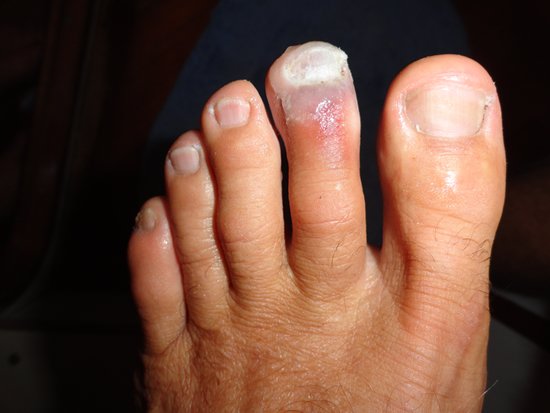
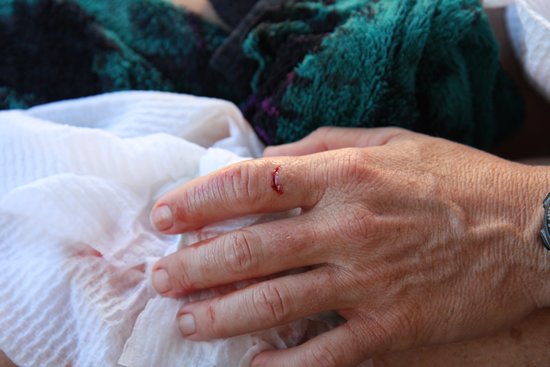
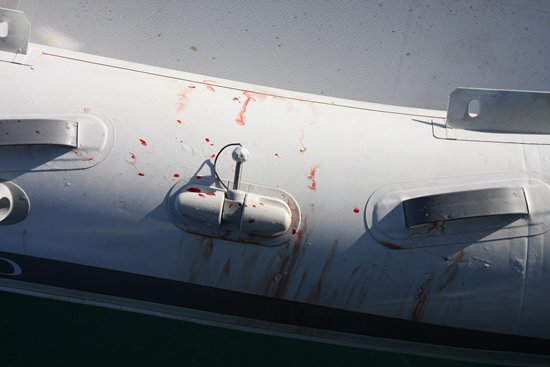
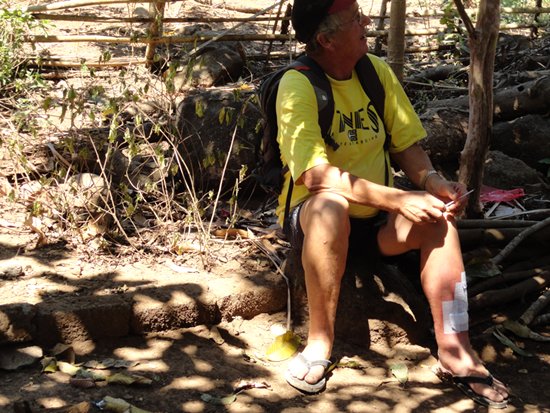
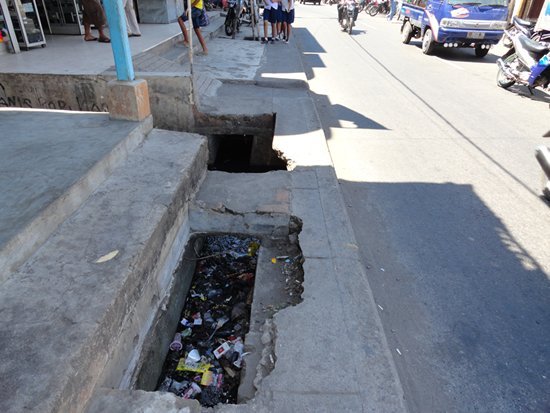
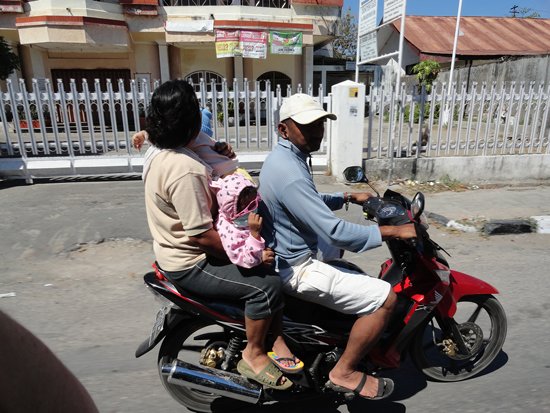

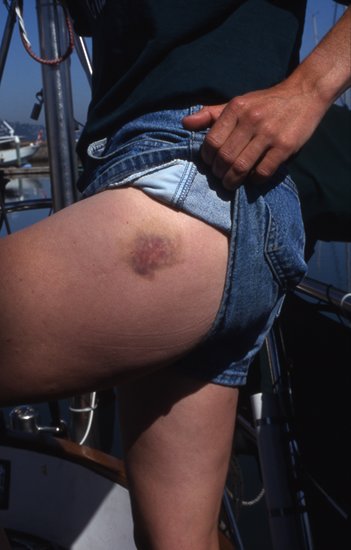
Warning!!! Some photos NOT for the Squeamish
A number of the members in our fleet are sporting bandages
of various sizes covering injuries that range in severity from scrapes and
scratches to serious infection. Pulled
muscles, back pain and “gimpy” knees are common complaints among those of us who
would otherwise be viewed as perfectly healthy specimens.
See photo #1 below of
my friend Milin, from Nae Hassle, and
me with our matching knee braces.

So, what’s up with all these medical maladies? I guess you could say it’s an “occupational
hazard” for cruisers as life at sea is quite often unstable. Sometimes, we find
ourselves REALLY rocking and rolling! We
always to try to reach out for a handhold down below if we have to move about
the cabin when the seas are rough, but, sometimes, an unintentional jibe or a
rogue wave will send us catapulting across the main salon or, worse yet, unceremoniously
jettisoned bare-assed out of the “head.”
(Yes, I have done that!) While
ocean-going vessels are designed with rounded corners and smooth edges, wood
and fiberglass are just plain HARD when you slam your knee or whack your “funny
bone” with the full force of unimpeded momentum.
Topsides, it’s not much better. There’s lots of “hardware” on deck and we’re
forever stubbing a toe, jamming fingers or banging a knee on some piece of
equipment. See #2 Peter’s really ugly toe which was jammed on
a cleat and #3 & #4 Jennifer’s finger which was caught between the outboard
engine and the transom of the dinghy aboard Green
Ghost.



Winches can be lethal weapons. In fact, I recently read an article about a woman
in Antigua who lost a hand while attempting to free a jam on an electronic winch
as she was hoisting her husband up the mast in a bosum’s chair! Don’t
worry! I don’t have a photo of that
particular mishap…
Injuries and medical emergencies are always a serious
concern for long-distance sailors due to the remote locations we find ourselves
in as well as the limited access to professional medical care in these out of
the way places. Safety procedures are
our highest priority and we try hard to keep ourselves out of harms’ way. But, no matter what, it seems that bumps and
bruises just go with the territory.
In most cases, we heal ourselves. Everyone on an ocean-going cruise carries a
sizeable medical kit and many of us have taken advanced first aid courses and
CPR training. Whenever the call goes out
for medical attention, there is always someone willing to lend a hand or
practical advice.
When we were crossing the Pacific, our good friend Jaime,
the Captain of Bionic Uno from Spain,
had a severe attack of kidney stones and was totally incapacitated while in the
middle of a 19-day crossing from the Galapagos Islands to the Marquesas. Another yacht, Miss Tippy, with a family of five aboard was almost 100 miles ahead
of Bionic Uno but they back-tracked
to assist the stricken Captain and his frightened spouse. The mother onboard Miss Tippy just happened to be a nurse and, without a moment’s
hesitation, she got in their dinghy in the middle of the ocean and pulled
herself hand-over- hand across a line thrown between the two boats. Once aboard Bionic Uno, she nursed her patient back to health and helped his
wife sail the Amel 54 over 1000 miles to the next port-of-call.
Here in Indonesia, we’ve encountered conditions which have given
rise to many first-aid emergencies.
For example, many of the towns we are visiting have never
hosted a sailing rally before. They have to accommodate us in anchorages that
aren’t really set up for large sailing yachts with dozens of dinghies ferrying
passengers back and forth from the boat to the shore. In most cases, the rickety piers that were
built long before we came on the scene don’t have ladders to help sailors climb
out of their dinghies up on to the dock.
What’s more, they often have loose or missing boards. As a result, many of us incur nasty cuts and
abrasions when soft flesh encounters rusty nails or splintered wood. I, for one, am thankful that I got a “booster
shot” for tetanus the last time I was home in Miami!
Take the case of Steve from Patamba… (Insert photo #5 of
Steve’s leg)

He fell climbing down a ladder in Lembata and what appeared
to be just a minor scratch, got seriously infected then turned frightfully red
and massively swollen! In the days after
the fall, his temperature soared and the pain was unbearable. He was dizzy and nauseous and his wife feared
she might have to fly him back to Darwin.
Luckily, he was able to see a doctor and got on a regimen of strong antibiotics.
He appears to be on the mend but this has taken almost three weeks.
There are also dangers onshore in these under-developed
countries. Walking along the crowded
streets, our attention is drawn in many directions and several of our fleet
members have had unfortunate experiences with the dangerous pathways. Gaping holes in the sidewalk, whose jagged edges
reveal sharp stones in the crumbling cement as well as rusty wire mesh or rebar,
have caused some nasty scrapes, cuts and bruises. These sidewalks are, quite often, right over the
public sewage drains and exposure to the toxic waste via open wounds is a cause
for serious concern.
Here’s a shot of the main street in Larantuka where walking
along the sidewalk requires extreme caution.

In Larantuka, a group of us attended a pre-Independence Day
celebration in a small village. Walking
in the dark, Bruce from Haven found himself
falling several feet into a drainage ditch.
This resulted in deep gashes and multiple abrasions to his leg. (Not to mention all the toxic muck that was
floating in that gully!) Luckily, we
were in a group traveling with the Regent (Governor) and one of his
staff members quickly found a house where they could clean and dress the wounds
sufficiently until Bruce returned to his boat.
He was lucky not to have been seriously hurt.
Doug from Shayele
was not so lucky. He and fellow
crewmember, Carol, rented a motorcycle in busy downtown Lembata and were hit by
a bus!
Now, I have to say, driving a motorcycle is something I
would NEVER do here. Indonesia has the 4th
largest population in the world and I would wager that they are close to 1st
place in terms of the number of motorcycles.
You take your life in your hands just WALKING down the street! These guys break for no man, woman or child
and they are some of the most aggressive drivers I have ever seen!
The streets are jam-packed with motorcycles usually carrying
one, two, three even four passengers. (See #7
photo of Dad, Mom and two kids below)

Often they are piled high and wide with cargo of all kinds. We once saw two guys balancing a mattress on
their heads as they weaved about the city of Kupang. Combine thousands of motorcycles with a
generous number of cars, trucks and the ubiquitous Bemo (a 10-12 passenger mini-bus that careens about town picking
up/dropping off passengers pretty much any place along a pre-determined route)
and you’ve got a traffic nightmare.
Back to Doug and Carol…. They were hit by a Bemo and, while
Carol was thrown free and escaped with just a bruised foot, Doug took the brunt
of the crash and the entire weight of the motorcycle fell down upon him. He was burned quite badly on one leg and
suffered injuries to both knees which, sadly, had only recently undergone
surgery for previous ligament damage.
Doug soon developed a massive infection in his burned leg and it was determined
that there was no suitable medical facility for him in Indonesia so he and
Carol have returned to Darwin leaving Anton, the Captain of Shayele without crew.
While most of our injuries are not quite as serious as
described above, it’s a rare day that passes without hearing about someone in
the fleet who has experienced a medical mishap.
(Here’s a shot of a
rope burn Nik from Green Ghost acquired when his ankle got caught in a runaway
spinnaker halyard. BTW, nice tatoo Nik!!!)

Whether it’s a rope burn, a goose-egg size bump on the
‘noggin, a black and blue toenail or maybe a missing fingertip sliced off
cutting a line or dicing an onion that we’re nursing…sooner or later, we’re all
among the Walking Wounded.
But, the aches and pains do go away. It’s just one aspect of life at sea that
makes for a good story. Most of us made the decision to leave our
safe, comfortable existence back home BEFORE we got too old or a medical
condition prohibited us from following our dream. So, you can be sure that we’re not going to let
a skinned knee or a little black and blue bruise stop us now!
